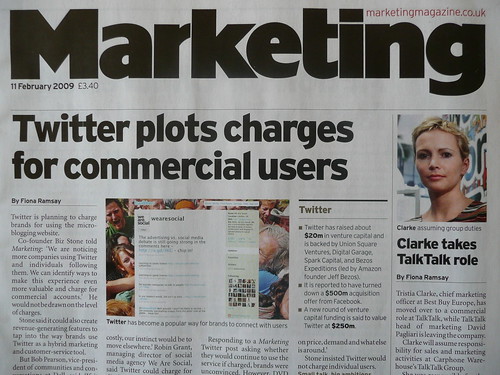On the front page of Marketing today…

The feature article in today’s Marketing, ‘Twitter enters the mainstream for brand communication‘ covers work we’ve done for three of our clients, with the obligatory introductory mention of Stephen Fry and his 130,000 followers, moving on to part of what we do for Skype:
Robin Grant, managing director of social media agency We Are Social, agrees that, if used wisely, Twitter can help reduce negative word-of-mouth online and assist with brand building. We Are Social client Skype, for instance, uses Twitter to ‘respond to people having issues with or asking questions about Skype’, according to Grant. ‘If we can respond, they tell their friends what brilliant customer service they’ve had from Skype.’
And then some of the work we’ve been doing with Ford:
Ford took more of a campaign approach to promote its latest Fiesta. It backed its ‘This is Now’ TV campaign with blog and Twitter activity encouraging consumers to submit photos and art and design-related discussion posts. Despite Ford’s Twitter activity, though, the car marque’s communications manager Lisa Brankin claims Twitter remains ‘niche in its appeal’. She adds: ‘By itself it is not strong enough but it can be valuable as part of a wider campaign.’
Twitter’s growth is heading in the right direction, but as We Are Social’s Grant argues: ‘Brands need to think carefully about what impact any commercial use of Twitter is likely to achieve before investing any significant resources in it.’
The cover story from Fiona Ramsay about Twitter’s plan to start charging brands (subsequently picked up by Techcrunch and others), starts from a quote straight from the horse’s mouth:
Co-founder Biz Stone told Marketing: ‘We are noticing more companies using Twitter and individuals following them. We can identify ways to make this experience even more valuable and charge for commercial accounts.’ He would not be drawn on the level of charges.
Stone said it could also create revenue-generating features to tap into the way brands use Twitter as a hybrid marketing and customer-service tool.
But Bob Pearson, vice-president of communities and conversations at Dell, said: ‘If it becomes complicated and costly, our instinct would be to move elsewhere.’ Robin Grant, managing director of social media agency We Are Social, said Twitter could charge for display ads or to access customer information for marketing.
I had quite a long philosophical conversation with Fiona about this when she was writing the article, and expressed my scepticism about Twitter charging for brands using Twitter normally (which is not entirely summed up with the quote she used, but it least got across the idea they’d look at charging for added value services rather than the standard free functionality). As I said in the comments of the article:
The challenge Twitter will face is that there’s such a grey line between personal and commercial use.
Aside from the celebrity issue, where they are clearly individuals, but using the service for commercial gain, it’s grey elsewhere too.
If I spend a lot of my time on Twitter talking about business related stuff, where does that leave me?
For brands overtly using Twitter, it’s not black and white either. Look at Ford’s Scott Monty for example (@ScottMonty), who uses his personal account to represent Ford. Even the account we run for Skype (@PeteratSkype) is as an individual not a brand (as is the same for most of Dell’s accounts). And of course Zappos famously have hundreds of employees on Twitter.
Let’s face it, one of the reasons that Twitter is popular is because it’s such an interesting mix of both your personal and your business life – in fact, unlike Facebook or LinkedIn, it lets you be the whole you. Twitter will be risking a lot if they try to change this.
Which has since proved to be correct, with Biz Stone publishing this clarification on the Twitter blog:
It’s great that both individuals and organizations are finding value in Twitter and there may be ways we can enrich the experience. In fact, we hope to begin iterating on revenue products this year.
However, it’s important to note that whatever we come up with, Twitter will remain free to use by everyone – individuals, companies, celebrities, etc. What we’re thinking about is adding value in places where we are already seeing traction, not imposing fees on existing services.